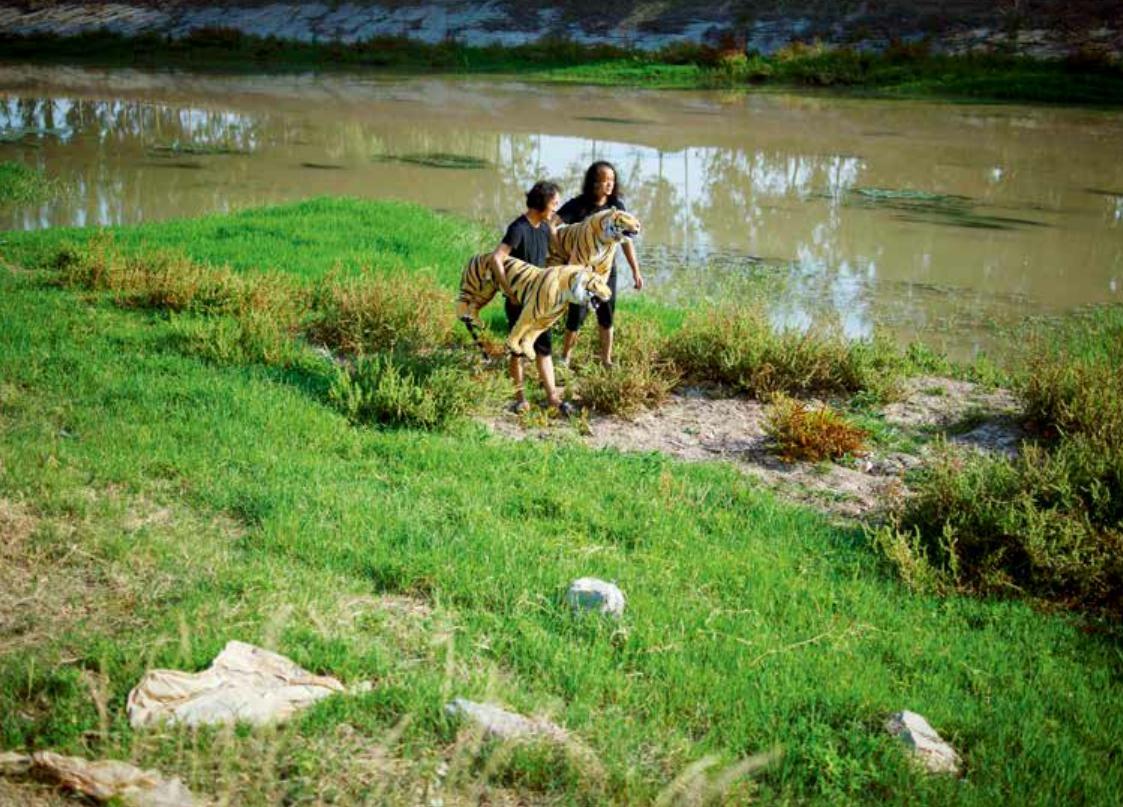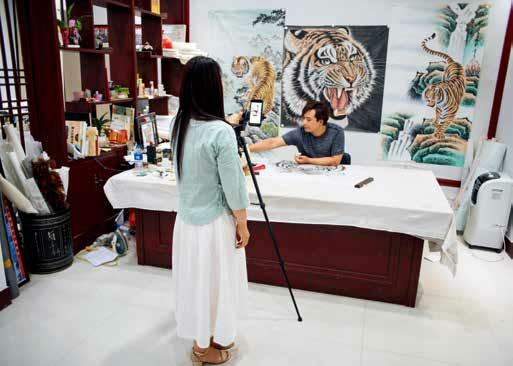Next-Gen Village Tiger Painters
2020-08-10byLinHongxianandYangYifan
by Lin Hongxian and Yang Yifan

The gentle wind across the green land stretching into the horizon signals that the cold winter has come to an end at the village where paintings of tigers hang in the rows of courtyards. The tranquil village, where most locals are surnamed Wang, is Wanggongzhuang in Beiguan Town, Minquan County, central Chinas Henan Province.
Wanggongzhuang is dubbed“Chinas number one tiger painting village” because 800 out of the 1,300 villagers there are skilled in painting tigers. Among them, two are members of the China Artists Association, and more than 50 members of the Henan Artists Association. Another 100 painters from other places have also settled in the village.
According to statistics from the local government, an average of around 90,000 tiger paintings produced in the village are sold each year to foreign markets. Although most of the sold paintings were about six feet in length, huge paintings depicting hundreds of tigers each are not uncommon. About 40 percent of the works created by Wanggongzhuang villagers are exported to countries that honor the tiger, such as Japan, Bangladesh, and South Korea.
Rise of the Tiger-Painting Industry
In the 1950s and 1960s, only a few villagers in Wanggongzhuang painted during the slack farming season. In those days, a handful of local people painted New Year pictures with traditional Chinese themes such as the Kitchen God and the Door God to be sold during Spring Festival to earn extra money. In the 1980s and 1990s, after the beginning of Chinas historic reform and opening up, several villagers led local farmers to commit to brushes and begin learning to paint tigers. The village gradually developed fame for its paintings of the animal.
Why tigers? Wang Jianmin, one of the first tiger painters in the village who is now 54 years old, believes the subject relates to the folk customs of eastern Henan. Many regard the tiger as the king of all the beasts with the magic power to drive out evil spirits. The custom of hanging tiger paintings has persisted since ancient times in the region.
Wang Jianmin is regarded by fellow villagers as a pioneer of the local tiger-painting industry. He was the first person in the village to realize that painting tigers could create business opportunities. Thirty years ago, Wang and his partners became dissatisfied with selling their paintings only in nearby towns. They started focusing on bigger cities. Later, one of his six-foot tiger paintings sold for 100 yuan (around US$14) in a city at a time when the average income of villagers in Wanggongzhuang was less than 30 yuan (around US$4) per month. The “big sale” caused a huge sensation. For a while, many villagers came to him to learn painting.
Tigers from Wang Jianmins brush are calm and gentle. He placed them in environments familiar to Chinese farmers such as lying beside a reed pond or surrounded by lotus flowers. The juxtaposition of images proved quite popular in the market. In Wang Jianmins words, he combined the tiger paintings with“aesthetic elements of rural China.”
Tiger Painting Sales in the Mobile Internet Era
At 36, Wang Jianfeng is the current village Party secretary of Wanggongzhuang. He started to learn traditional Chinese realistic painting at the age of 13 from a famous local tiger-painting artist. He explained that in contrast with the older-generation painters, young artists tend towards using bright colors to highlight the ferociousness of tigers, rather than relatively warm colors to make the tiger look milder.
Wang Jianfeng became the first person in Wanggongzhuang to harness live streaming to sell his works as he saw business opportunities emerge with the development of the mobile internet and the popularization of short videos and live streaming. He began to explore new channels for painting sales. Except for live streaming, his wife also filmed his painting process and posted videos on the internet. Today, Wang Jianfeng has more than 110,000 followers on social media platforms. When the market is good, his maximum monthly income from online sales can reach as much as 500,000 yuan (US$72,084). Using the internet to sell tiger paintings has become a trend in Wanggongzhuang. Statistics show that about a third of paintings produced there are sold online. However, Wang Jianfeng believes that the growth of online sales does not hurt offline sales. “Most of what we sell online are mediocre works,”he revealed. Big spenders prefer to see the paintings in person before purchasing. Today, about 70 people are employed as agents and distributors for the village. They earn commissions selling the tiger paintings throughout China. Such people keep close eyes on the domestic art market.
Combining Art and Industry
Since 2006, the local government of Minquan County has offered art courses to local residents, with an aim to promote further development of the tiger-painting industry. “I hope more and more villagers take tiger painting to heart rather than just looking to it for income,”declared An Desheng, director of the Cultural Industry Office of Beiguan Town in Minquan County.
Fortunately, a younger generation armed with internet expertise is poised to take tiger paintings to a wider and untapped market. In his 20s, Wang Jingheng is a local villager who once studied painting at an academy of fine arts.
“The older generation lacks a theoretical basis of painting,” Wang Jingheng said while sitting in his fathers art studio. “If young people just stayed home and learned from their fathers, their vision would be narrow, and it would be more difficult to adapt to the market.”
Although his tiger paintings still sell for less than his fathers, Wang Jingheng is confident about his future. He anticipates boosting his selling price through innovation. “A tiger with wings in blazing colors would not fly with my fathers generation, but it could be precisely what the future market and buyers need.”